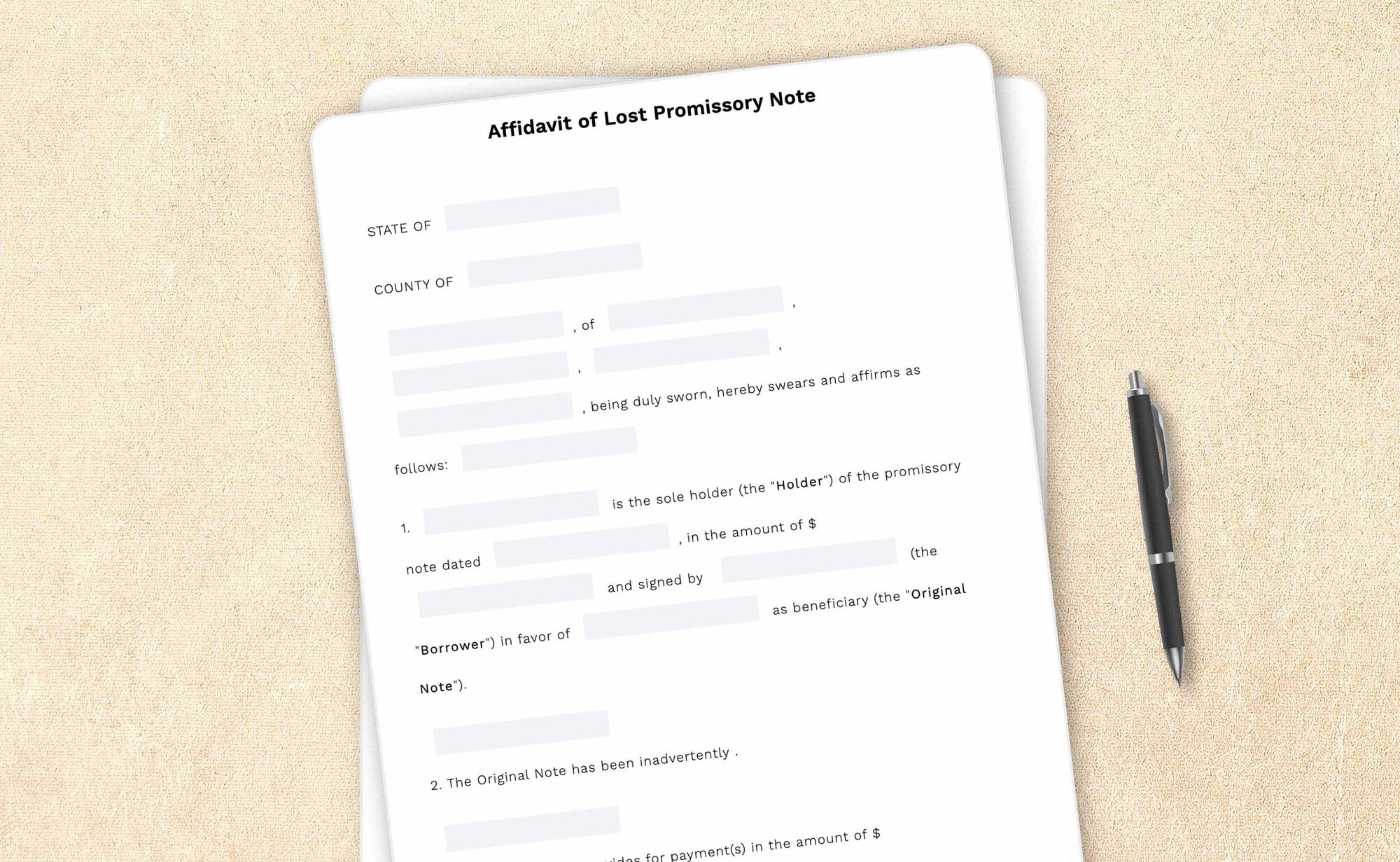STATE OF
COUNTY OF
1.
2. The Original Note has been inadvertently
3. The Original Note provides for
5. Neither the Original Note nor any part of the Holder's rights in the Original Note has, in whole or in part, been sold, transferred, or assigned to any other person or entity.
6. The existence and terms of the Original Note have not been contested by the Borrower and all conditions of the loan agreement between the Holder and the Borrower have otherwise been met.
7.
8. If the Holder locates the Original Note, or if it is otherwise returned to the Holder, the Original Note will have no value and the Holder will surrender the Original Note to the Borrower immediately and without consideration.
9. The Holder asks, and is making this affidavit for the purpose of requesting, that the Borrower execute a duplicate note as a substitute for the Original Note.
The Holder is signing this affidavit on the date set forth below.
Date: ______________________
______________________________________
Signature of
| STATE OF |
|
| COUNTY OF |
|
| Subscribed and sworn to before me this __________day of ____________, 20_____, at ___________, __________________. |
| _________________________________________ | |
| Signature of Notary Public | |
| Name of Notary Public: ____________________________ | (SEAL) |
| Notary Public, State of |
|
| My commission expires: ___________________________ |
How-to guides, articles, and any other content appearing on this page are for informational purposes only, do not constitute legal advice, and are no substitute for the advice of an attorney.
Affidavit of lost promissory note: How-to guide
Individuals and companies often must borrow money to keep businesses afloat and will provide evidence of this borrowing with promissory notes.
Lenders keep these notes in many locations, from organized files in safe deposit boxes to cardboard boxes in the garage.
No matter the system, physical documents can easily be misplaced or destroyed. In such cases, borrowers must execute new documents, which starts with completing a lost note affidavit.
It is generally accepted that the lender who loses their promissory note can enforce the debt it represents by signing an affidavit of the lost promissory note. This may prevent the investment loss the lender would otherwise face if a third party found the note before the lender reported it missing. This also protects the interests of the borrower, who may be a colleague or close friend.
Learn about promissory notes in depth

1. Understanding promissory notes
A promissory note is, at its core, the acknowledgment of a debt. It is a written promise to repay that debt in a specific way and can be transferred by the lender to a third party. Because of this easy transferability, losing the document can have dire consequences for the lender. The individual holding the document is often the only one who can enforce it.
2. Importance of promissory notes
Protect promissory notes, as these are valuable documents and should be treated as such. If you're concerned about the cost and risk of housing the documents, consider getting a safety deposit box. Note that a borrower isn't released from their responsibilities when a promissory note is lost or destroyed, but keeping a close eye on the document will prevent disputes and other difficulties in the future.
3. Course of action to follow when a promissory note is lost
When the lender finds out the promissory note has been lost or destroyed, notify the borrower. Write a fresh note and complete the affidavit as soon as possible. It could be challenging to cancel and get a new note if an unsuspecting buyer finds the one the lender misplaced. The borrower can find himself in a challenging situation, and the lender might lose their investment forever.
The lender can obtain replacement notes and make copies of those documents. This may help if those replacement notes are later lost or destroyed.
4. Check the original loan agreement
Review the terms of the loan agreement and, if available, a copy of the note itself. In some cases, procedures may be in place to address lost or damaged promissory notes. For example, some promissory notes contain provisions like the following:
“If this promissory note becomes mutilated or defaced, or is destroyed, lost, or stolen, the borrower shall execute and deliver a new note of like principal amount in exchange and substitution for the mutilated or defaced note, or in lieu of and in substitution for the destroyed, lost, or stolen note. If a note is mutilated or defaced, the lender shall surrender such note to the borrower. If any note becomes destroyed, lost, or stolen, the lender shall furnish satisfactory evidence of the destruction, loss, or theft of such note to the borrower.”
Such provisions require the borrower’s cooperation in signing a new promissory note if the lender provides good evidence that the original was lost or destroyed.
5. Verify the applicable law
Most states have laws governing the enforceability of lost, destroyed, or stolen “negotiable instruments,” including promissory notes. These can usually be found in the Uniform Commercial Code (or equivalent) under a title such as “Enforcement of Lost, Destroyed, or Stolen Instrument” or “Enforcement by Person Not in Possession of Instrument.” These laws are meant to provide adequate protection to a borrower and generally require that the lender both
- Prove the terms of the note, and
- Prove the lender’s right to enforce the note
In some states, the signing and notarization of an affidavit will be sufficient to prove both the terms and the lender’s right of enforcement. In others, additional steps may be required, such as the lender’s indemnification of the borrower against third-party demands for money under the note.
Key points to add in an affidavit of lost promissory note

The following instructions will help the lender understand the terms of the affidavit:
Point 1:
Describe the note that was lost in detail. Add the following information:
- Holder's name, often the last person or company that had possession of the document
- Effective date
- Full value
- Name of the borrower and, if the borrower is a company, the person who signed the note on its behalf
- Name of the beneficiary
Point 2:
Add the correct description of what happened to the note. This is the opportunity to explain the steps taken to find the missing note. Be as specific as possible, showing the lender’s efforts to find the document. If the note was destroyed, explain the circumstances of that event.
Point 3:
Use this paragraph to provide additional details about the note. Feel free to adapt the details in the sample to suit the arrangement (e.g., payment terms, type of note, etc.).
Point 4:
In this section, insert the amount that has yet to be paid based on the note.
Point 5:
Here, indicate that the note hasn't been sold or transferred to any third party. In other words, no other person or company has an interest in or can claim money under the note.
Point 6:
This point states that both parties agree that the note exists and the borrower owes a valid debt to the holder. It also indicates that neither party is in default or owes any current obligation under the note (other than the periodic rights to and of payments).
Point 7:
If the lender has a copy of the note, attach it to this affidavit. If not, this section verifies that the note's description above is true and correct.
Point 8:
Sometimes, when the note is lost and then found again, the borrower could face the problem of double debt. This section constitutes the holder’s promise that if it does locate the original note, it'll be returned to the borrower and not treated as a separate debt.
Point 9:
Explains that the purpose of the affidavit is to get the borrower to sign a substitute note. Notarize the signature on the affidavit by going to the notary public.
Frequently asked questions
What's an affidavit of a lost promissory note?
Whether you keep a promissory note in a safe or a shoe box, there's always a chance it could get lost or damaged. A promissory note is proof a loan's been made, and an affidavit is a promise that what you're signing is accurate. Creating new documents would have to start with an affidavit of the lost promissory note.
An affidavit of a lost note is a legal document that says a promissory note with information about the lender giving money to the borrower is lost.
What happens when a promissory note is lost?
When a promissory note is lost, the lender must write an affidavit for the lost note to prevent any investment loss. Here are the contents needed to complete an affidavit of lost promissory note:
- How much the promissory note was for: Know the principal amount and how payments were made
- What happened to the promissory note: Was it lost, stolen, or destroyed
